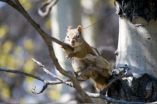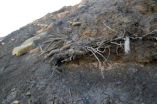(Press-News.org) MANHATTAN, KS – For years, gardeners have claimed that putting Bounce® fabric softener sheets in their pockets is an effective way to repel pests like mosquitoes and gnats. Any Internet search will uncover countless articles about the bug-repelling properties of Bounce®. Are these claims valid or simply folklore? The authors of a new study say that until now, no quantitative data has existed to substantiate these claims, but their latest research has revealed a definitive answer: Bounce® sheets do indeed repel adult gnats.
In a report just published in HortScience, Kansas State University Department of Entomology professor Raymond Cloyd and colleagues discussed a series of five replicated experiments they conducted to ascertain whether Bounce® dryer sheets (Outdoor Fresh Scent™, Procter and Gamble) repel fungus gnat adults under laboratory conditions. "In all five experiments, the mean proportion of fungus gnat adults collected in the sample compartments containing the dryer sheets were significantly fewer, ranging from 12% to 18% ,whereas the compartments without dryer sheets contained 33% to 48% of the fungus gnats released in the arena", said Cloyd. "This study is the first to demonstrate that Bounce® original brand fabric softener dryer sheets repel fungus gnat adults under laboratory conditions."
The research team also analyzed the volatile compounds in the dryer sheets using gas chromatography–mass spectrometry. One of the major volatile compounds detected in Bounce® was linalool, a colorless monoterpene alcohol used by cosmetic and perfume companies for its flower-like odor. Linalool—present naturally in plants such as lavender, marjoram, and basil—has been shown to be toxic to a number of different mites and insects. The experiments also indicated high levels of the volatile compound beta-citronellol, found in plants including rose geranium, citronella, and lemon balm, and known for its ability to repel mosquitoes.
The authors say there are still important issues that need to be resolved before Bounce® can be widely recommended, but note that in the future, "the use of dryer sheets may be an alternative strategy to deal with fungus gnat populations in greenhouses."
###
The complete study and abstract are available on the ASHS HortScience electronic journal web site: http://hortsci.ashspublications.org/cgi/content/abstract/45/12/1830
Founded in 1903, the American Society for Horticultural Science (ASHS) is the largest organization dedicated to advancing all facets of horticultural research, education, and application. More information at ashs.org
Fabric softener sheets repel gnats
Scientists prove Bounce sheets fend off insect pests
2010-12-16
ELSE PRESS RELEASES FROM THIS DATE:
Put on the brakes after foot or ankle surgery
2010-12-16
Patients recovering from a right foot injury or surgery should think twice about how soon they want to begin driving again. According to a new study from the Journal of Bone and Joint Surgery (JBJS), it takes much longer to brake when the driver is wearing an immobilization device - like a splint or brace, than it does when wearing normal footwear.
Driving is important to many people's social and professional lives, so when a person's right ankle or foot must be immobilized after an injury or surgery, one of the first questions an orthopaedic surgeon hears is, "When can ...
Marinomed's iota-carrageenan effective against H1N1
2010-12-16
Carrageenan, is a polymer derived from red seaweed which helps to create a protective physical barrier in the nasal cavity and has proven to be an effective antiviral in the treatment of the common cold. The present study assessed the efficacy of Carrageenan against influenza viruses, including the pandemic H1N1 influenza strain. Results showed that the polymer directly binds to influenza viruses, effectively blocking the virus from attaching to cells and spreading further. In animal experiments, Carrageenan demonstrated equivalent efficacy when compared to the drug Tamiflu. ...
Plant consumption rising significantly as population grows and economies develop
2010-12-16
Humans are consuming an increasing amount of the Earth's total annual land plant production, new NASA research has found.
As the human population continues to grow and more societies develop modern economies, this rate of consumption is increasing both as a whole and on a per capita basis globally. In addition to as food, plants are consumed for paper, clothing, livestock feed, firewood, biofuels, building and packaging materials, among other uses.
A NASA research group led by Marc Imhoff at NASA's Goddard Space Flight Center, Greenbelt, Md., first quantified this global ...
New research finds delaying surgical procedures increases infection risk and health care costs
2010-12-16
CHICAGO (December 15, 2010) – Delaying elective surgical procedures after a patient has been admitted to the hospital significantly increases the risk of infectious complications and raises hospital costs, according to the results of a new study in the December issue of the Journal of the American College of Surgeons.
The occurrence of infection following surgical procedures continues to be a major source of morbidity and expense despite extensive prevention efforts that have been implemented through educational programs, clinical guidelines, and hospital-based policies. ...
Opportunity leads to promiscuity among squirrels, study finds
2010-12-16
University of Guelph researchers have finally figured out why female squirrels are so darn promiscuous. Turns out it has nothing to do with genes and everything to do with how many males are knocking at their door.
"Their behaviour is overwhelmingly influenced by opportunity," said graduate student Eryn McFarlane, who, along with integrative biology professor Andrew McAdam and a team of researchers from across Canada, solved a mystery that has baffled biologists for years.
Their findings appear in the Royal Society Journal Biology Letters.
Female squirrels are less ...
'Green genes' in yeast may boost biofuel production by increasing stress tolerance
2010-12-16
An effort to increase biofuel production has led scientists to discover genes in yeast that improve their tolerance to ethanol, allowing them to produce more ethanol from the same amount of nutrients. This study, published in the December 2010 issue of Genetics (http://www.genetics.org), shows how genetically altered yeast cells survive higher ethanol concentrations, addressing a bottleneck in the production of ethanol from cellulosic material (nonfood plant sources) in quantities that could make it economically competitive with fossil fuels.
"Our hope is that this ...
Ancient forest emerges mummified from the Arctic
2010-12-16
SAN FRANCISCO -- The northernmost mummified forest ever found in Canada is revealing how plants struggled to endure a long-ago global cooling.
Researchers believe the trees -- buried by a landslide and exquisitely preserved 2 to 8 million years ago -- will help them predict how today's Arctic will respond to global warming.
They also suspect that many more mummified forests could emerge across North America as Arctic ice continues to melt. As the wood is exposed and begins to rot, it could release significant amounts of methane and carbon dioxide into the atmosphere ...
New colonoscopy skills assessment tool developed for trainees
2010-12-16
OAK BROOK, Ill. – Dec. 15, 2010 – Researchers at the Mayo Clinic in Rochester, Minn., have developed a new skills assessment tool for colonoscopy trainees. A report outlining the development and validation of the Mayo Colonoscopy Skills Assessment Tool (MCSAT), designed for the assessment of cognitive and motor skills during colonoscopy training, appears in the December issue of GIE: Gastrointestinal Endoscopy, the monthly peer-reviewed scientific journal of the American Society for Gastrointestinal Endoscopy (ASGE).
Ensuring that gastroenterology fellows and surgery ...
Missing molecules hold promise of therapy for pancreatic cancer
2010-12-16
By determining what goes missing in human cells when the gene that is most commonly mutated in pancreatic cancer gets turned on, Johns Hopkins scientists have discovered a potential strategy for therapy.
The production of a particular cluster of genetic snippets known as microRNAs is dramatically reduced in human pancreatic tumor cells compared to healthy tissue, the researchers report in a study published Dec. 15 in Genes and Development. When the team restored this tiny regulator, called miR-143/145, back to normal levels in human pancreatic cancer cells, those cells ...
Nanoscale gene 'ignition switch' may help spot and treat cancer
2010-12-16
In a proof of principal study in mice, scientists at Johns Hopkins and the Virginia Commonwealth University (VCU) have shown that a set of genetic instructions encased in a nanoparticle can be used as an "ignition switch" to rev up gene activity that aids cancer detection and treatment.
The switch, called a promoter, is a set of chemical letters that interacts with DNA to turn on gene activity. In this case, the scientists used a promoter called PEG-Prom, cloned by VCU researcher Paul Fisher, Ph.D. PEG-Prom is activated only when inside cancer cells, not in normal ones.
"With ...
LAST 30 PRESS RELEASES:
Why nail-biting, procrastination and other self-sabotaging behaviors are rooted in survival instincts
Regional variations in mechanical properties of porcine leptomeninges
Artificial empathy in therapy and healthcare: advancements in interpersonal interaction technologies
Why some brains switch gears more efficiently than others
UVA’s Jundong Li wins ICDM’S 2025 Tao Li Award for data mining, machine learning
UVA’s low-power, high-performance computer power player Mircea Stan earns National Academy of Inventors fellowship
Not playing by the rules: USU researcher explores filamentous algae dynamics in rivers
Do our body clocks influence our risk of dementia?
Anthropologists offer new evidence of bipedalism in long-debated fossil discovery
Safer receipt paper from wood
Dosage-sensitive genes suggest no whole-genome duplications in ancestral angiosperm
First ancient human herpesvirus genomes document their deep history with humans
Why Some Bacteria Survive Antibiotics and How to Stop Them - New study reveals that bacteria can survive antibiotic treatment through two fundamentally different “shutdown modes”
UCLA study links scar healing to dangerous placenta condition
CHANGE-seq-BE finds off-target changes in the genome from base editors
The Journal of Nuclear Medicine Ahead-of-Print Tip Sheet: January 2, 2026
Delayed or absent first dose of measles, mumps, and rubella vaccination
Trends in US preterm birth rates by household income and race and ethnicity
Study identifies potential biomarker linked to progression and brain inflammation in multiple sclerosis
Many mothers in Norway do not show up for postnatal check-ups
Researchers want to find out why quick clay is so unstable
Superradiant spins show teamwork at the quantum scale
Cleveland Clinic Research links tumor bacteria to immunotherapy resistance in head and neck cancer
First Editorial of 2026: Resisting AI slop
Joint ground- and space-based observations reveal Saturn-mass rogue planet
Inheritable genetic variant offers protection against blood cancer risk and progression
Pigs settled Pacific islands alongside early human voyagers
A Coral reef’s daily pulse reshapes microbes in surrounding waters
EAST Tokamak experiments exceed plasma density limit, offering new approach to fusion ignition
Groundbreaking discovery reveals Africa’s oldest cremation pyre and complex ritual practices
[Press-News.org] Fabric softener sheets repel gnatsScientists prove Bounce sheets fend off insect pests

